
|
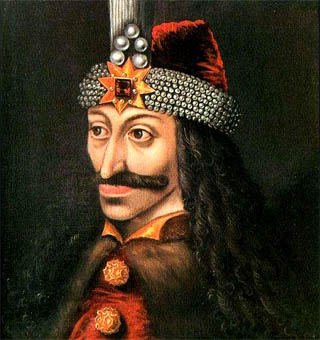
Vlad
III, sometimes known as Dracula or Vlad the
Impaler.
|
One of the most influential books in the horror
genre is Bram Stoker's 1897 novel Dracula. Stoker, who
was a manager of the world-renowned Lyceum Theatre in London,
supplemented his income by writing stories. His books include
The Lair of the White Worm, The Jewel of Seven Stars,
and The Mystery of the Sea. However, it is his narrative
about the vampire Count from Romania who invaded London for
which the Irish author is most well remembered.
Stoker often researched his subjects carefully
and included descriptions of real places and people in his stories.
Dracula is no exception. Stoker was inspired by folktales
from Eastern Europe about vampires and incorporated many of
these legends into the novel. He had almost completed his book
under the original title of The Un-Dead when he came
across a historical figure that changed both the label of the
book and the name of the main character. The figure was a 15th
century Prince of Wallachia named Vlad III. Because his father
was a member of the Order of the Dragon and had taken the name
Dracul, Vlad was often referred to as "the son of Dracul"
which in Latin was Dracula. Because of his preferred
method executing his enemies, however, he was commonly known
as "Vlad the Impaler."
The
Impaler Prince
Vlad III was born late in the year 1431 in the
Transylvanian city of Sighisoara. His father, Vlad II, was a
nobleman living in exile. The same year Vlad II was born his
father was inducted into the secretive "Order of the Dragon."
The order, founded in 1410 by Sigismund the Holy Roman Emperor,
demanded the members defend Christianity and resist the Ottoman
Turks who were Muslims.
|
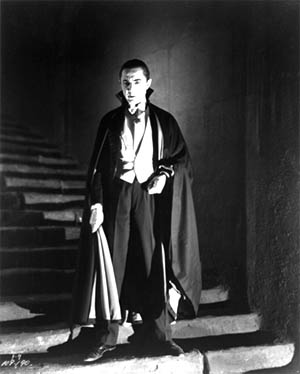
Bela
Lugosi portrayed the Prince in the 1931 film version of
Stoker's famous book.
|
In 1436 Vlad's father took over the throne of
Wallachia, a region of what is now Southern Romania. He was
removed from power six years later by rivals and decided the
best way to get the throne back was to switch sides, betray
his oath to the order, and ally himself with the Ottoman Sultan.
As proof of his new loyalty, Vlad's father sent two of his sons,
Vlad III and his younger brother Radu, to the court of the Sultan
to be held hostage. Radu (known as "Radu the handsome") did
well at the court and eventually converted to Islam. Vlad, however,
was a problem child. He didn't get along with his tutors and
trainers and was angry at his father for favoring his older
brother, Mircea, and betraying his pledge to the Order of the
Dragon (into which Vlad III had also been inducted at age 5).
He was also angry at his younger brother for leaving Christianity.
His bad attitude earned him beatings, imprisonment and this
gave him a hatred for the Ottoman Turks.
Eventually, Dracula was released on the promise
of good behavior and continued his education at the Court, learning
how to handle weapons and ride horses as well as getting an
education on subjects like religion and logic. He also became
fluent in several languages.
Dracula's father was overthown in 1447 by some
of the Wallachia chieftains (known as boyars) with some
help the Hungarian King John Hunyadi. In the same attack Vlad's
older brother, Mircea, was blinded, then buried alive.
Fearing this would give Hungaria too much influence
in Wallachia, the Ottomans marched in and put Vlad III on the
throne. His rule lasted only a few months before Hungaria also
invaded the kingdom, threw Dracula out and put a rival prince
on the throne in his place.
Dracula fled the country and wound up living under
his uncle's protection in Moldavia. When his uncle was killed,
in 1451, he decided to go to his former enemy, the Hungarian
regent John Hunyadi for help. Hunyadi was impressed by the then
twenty-year-old Vlad. The boy understood the interworkings of
the Ottoman court and had a special hatred for the new Sultan,
Mehmed II. In 1456 he backed Vlad III in a successful bid to
retake the Wallachia throne.
|

The
Turkish Sultan Dracula hated so much, Mehmed II.
|
The
Prince Comes to Power
Once Dracula came back into power he moved quickly
to secure his country. All the warring had left Wallachia in
a terrible state: crime was rampant, agriculture was failing
and trade was non-existent. Knowing that a nation in this situation
would never be able to resist the Ottoman Empire, he enacted
new laws and backed them with severe punishments for those that
disobeyed.
It is for these actions that Vlad received his
rather unpleasant nom de plume. Impalement is an exceedingly
painful and ugly way to die. The victim has a large, sharpened,
wooden stake driven through his body. In the method used by
Dracula, the stake would be pushed through the body from either
front to back or back to front in a manner that would not damage
vital organs leading to immediate death. The stake would then
be planted vertically into a prepared hole in the ground so
that the victim was suspended in the air. Victims would be faced
with hours or even days of agony before they expired. The stakes
baring their gastly loads would be left in prominent locations
to remind other would-be-enemies of the Prince the price of
disobeying or betraying him.
Dracula did not invent impalement, the harsh punishment
had been around for centuries, but he used it liberally. On
Easter Sunday of 1457 Vlad rounded up the boyars that had opposed
his father and killed his brother. All the older ones were impaled
while the rest were marched to the ruins of Castle Poenari in
the mountains above the Arge River, 40 miles north of the town
of Tārgovite. Here they were forced to rebuild the fortress
for the prince until most of them died of exhaustion. Those
that survived untl the fortress was finished were also impaled.
The castle, built with blood and perched on a steep, inaccessible
precipice of rock, became one of Vlad's most important strongholds.
The prince worked to systematically eradicate
the boyar class, replacing them with men from the lower ranks
that would be loyal only to him. Since the boyars had been related
to and supported by the Saxons of nearby Transylvania, Vlad
also carried out a number of raids into their lands also impaling
some of these settlers of German decent.
|

Dracula's
deadly Night Attack as painted by Theodor Aman.
|
Dracula
Goes to War
In 1459, Pope Pius II called for a new crusade
against the Ottomans. Most European leaders by this time were
tired of war and showed little enthusiasm for another expensive,
bloody campaign. Matthias Corvinus, son of John Hunyadi, the
King of Hungary, and an ally of Dracula, recommended that Vlad
pay a tax on non-Muslims that the Turkish Sultan demanded so
as to keep the peace. Vlad, however, hating the Ottoman Turks,
and particularly Sultan Mehmed II, used a visit by the Sultan's
envoys over the tax to provoke a war. Because the envoys did
not raise their "hats" to him, Vlad had their turbans nailed
to their heads, resulting in their deaths.
The Sultan then sent a force of 10,000 cavalry
to deal with Vlad. The prince, however, set up a clever ambush
in a narrow mountain pass. He surrounded the Turks and defeated
them. Those of the Sultan's army that survived the battle were
impaled. Their leader, Hamza Pasha, was mounted on the highest
stake to show his rank.
In the winter of 1462 Vlad started carrying out
raids across the Danube River into Bulgaria killing 23,000 Muslims.
The Sultan responded by sending a force of 90,000 against the
prince. Dracula's troops were outnumbered by more than two to
one. Unable to stop the Sultan's advance by traditional means,
Vlad employed "guerilla warfare" to harass the Turks. This included
poisoning water sources, diverting streams to create swamps
that had to be crossed and sending people suffering from lethal
diseases, such as leprosy and tuberculosis, to mix with the
Sultan's forces.
|
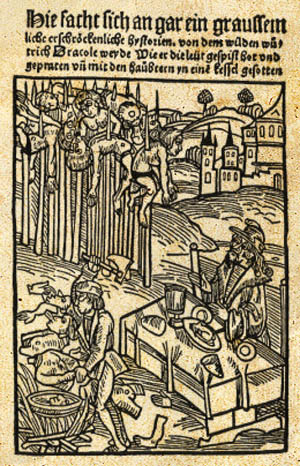
Vlad
III overseeing an impalements while eating dinner in a
woodblock image.
|
The night of June 17, 1462, Vlad and his troops
infiltrated the Turkish camp taking advantage of the Sultan's
order that his soldiers be confined to their tents after dark.
Dracula's forces then attacked using burning torches and sounding
bugles to create confusion. In this engagement (which is referred
to as "The Night Attack") the Sultan lost 15,000 men in the
skirmish which lasted three hours.
Though this demoralized his troops, it was not
enough to stop the Sultan in his determination to take the capital
of Wallachia. As he approached the city, however, he found no
resistance. Instead, the 60 mile long road to the capital was
lined with the bodies of 20,000 impaled Turks and Muslim Bulgarians.
The Sultan, horrified at the slaughter, headed home leaving
the campaign to his subordinates including Vlad's brother, Radu.
The war continued eventually, draining Vlad of
money. He went to Hungary to ask for help from King Matthias
Corvinus. Matthias had been given a sum of money from the Pope
to be spent on the war, but had wasted it on personal expenses.
To hide his crime he denounced Dracula and using false documents
arrested him and threw him in prison. Vlad was finally released
in late 1476 and attempted to retake Wallachia, but died in
battle with the Turks a few months later.
Lurid
Stories
The prince did not receive his nickname until
well after his death. However, even while still alive in 1462,
a pamphlet appeared in Germany describing the prince's proclivity
for impalement and other sadistic acts. It was probably written
by a Saxon with an axe to grind who was not too happy with the
treatment Vlad had given the Saxon settlers.. Over time a number
of different German pamphlets and manuscripts came out along
with a poem by Michel Beheim entitled, Story of a Madman
Called Dracula of Wallachia. In these stories Vlad's exploits
were greatly exaggerated with huge numbers of victims ranging
from 40,000 to 100,000 men, women and children. The atrocities
he was accused of just weren't impalements but included torturing,
burning, skinning, roasting, and boiling people alive. Originally
these tales were written just to blacken Vlad's repuation for
political purposes, but over time they simply became a form
of lurid entertainment.
|
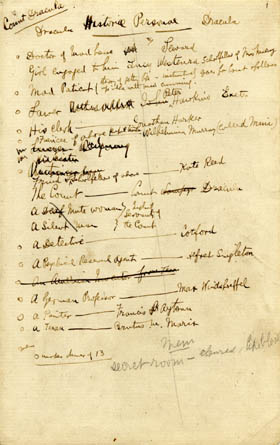
A
sheet of notes made by Stoker while working on his most
famous book.
|
In addition to the German stories, Matthias Corvinus
undoubtedly spread a number of vicious rumors about the prince
in order to discredit him with the Pope. It was these stories,
along with the German tales, that Stoker heard when he decided
to make Prince Dracula the villain of his book.
Stoker and others clearly added some of Vlad's
real history into the Dracula legend. In one speech in the book
Stoker has the Count tell about his battles with the Turks and
the betrayal of his brother. Later, in Francis Ford Coppola's
1992 film Bram Stoker's Dracula the script writers added
a scene where Dracula's wife (played by Winona Ryder) commits
suicide by jumping into the river after an arrow is shot through
the castle window bearing a note telling her that her husband
has died in battle. This was apparently taken from a local legend
that Vlad's first wife died when an arrow with a note arrived
warning her that the Turks were about to take her palace. Dracula's
wife said she would rather be eaten by the fish than be captured
by the Turks and leapt from a cliff into the river.
National
Hero
While Western Europeans have always seen the prince
as a symbol of evil, Eastern Europeans have had a different
take. There is a set of Russian stories like the German pamphlets
entitled The Tale of Warlord Dracula. In many ways they
are very similar to the German accounts except they take the
attitude that the Wallachian Prince was a strong, good ruler
and a great soldier.
Even today many within his native land consider
him a tough-minded national hero who stood up to foreign invaders.
His release by Matthias in 1476 was partly under pressure from
public opinion. Many important people regarded him as a champion
of Christiandom. Around 1800 the Romanian author, Budai-Deleanu,
wrote an epic heroic poem in which Prince Vlad is shown as a
ferocious warrior fighting the advances of the Ottomans. In
a poll taken in Romaina in 2006, Vlad was named as one of the
"100 Greatest Romanians" of all time. Today a bust of Dracula
is proudly displayed at his birthplace near Sighioara, Transylvania.
|
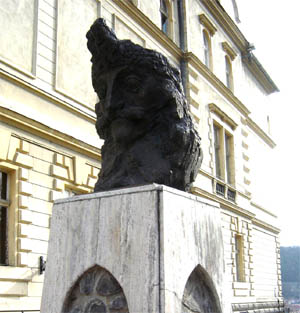
A
bust of Vlad III near his birthplace.
|
So, while Stoker choose an interesting historical
person to remake into the villain in his novel, not every rumor
and story that circulates about Vlad the Impaler are actually
true. Clearly you didn't want to get on his bad side, but he
wasn't insane or as sadistic as pictured in many of the German
tales. Most importantly, unlike Stoker's Dracula, he was never
a vampire.
Or was he? In the early 1900's Prince Dracula's
grave was exhumed for research. It was empty. Was Vlad III simply
buried somewhere else? Or does he still walk among us today?
A Partial Bibliography
Dracula, A Biography of Vlad
the Impaler, Radu Florescu and Raymond McNally, Hale, 1974
In Search of Dracula,
Radu Florescu and Raymond McNally, Hale, 1973.
Dracula: Prince of many faces
- His life and his times by McNally, T. Raymond, Little,
Brown and Company, 1989.
DRACULA: between myth and
reality, by Adrian Axinte, Standford.edu, http://www.stanford.edu/group/rsa/content/public/htm/dracula.shtml

Copyright
2011 Lee Krystek. All Rights Reserved.